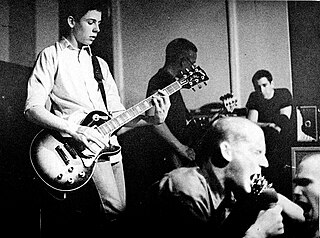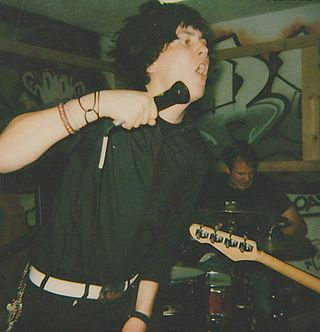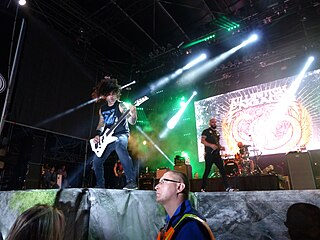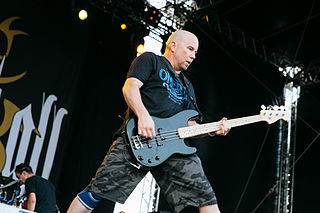Grindcore is an extreme fusion genre of heavy metal and hardcore punk that originated in the mid-1980s, drawing inspiration from abrasive-sounding musical styles, such as thrashcore, crust punk, hardcore punk, extreme metal, and industrial. Grindcore is considered a more noise-filled style of hardcore punk while using hardcore's trademark characteristics such as heavily distorted, down-tuned guitars, grinding overdriven bass, high-speed tempo, blast beats, and vocals which consist of growls, shouts and high-pitched shrieks. Early groups such as England's Napalm Death are credited with laying the groundwork for the style. It is most prevalent today in North America and Europe, with popular contributors such as Brutal Truth and Nasum. Lyrical themes range from a primary focus on social and political concerns, to gory subject matter and black humor.

The punk subculture includes a diverse and widely known array of music, ideologies, fashion, and other forms of expression, visual art, dance, literature, and film. Largely characterised by anti-establishment views, the promotion of individual freedom, and the DIY ethics, the culture originated from punk rock.

Hardcore punk is a punk rock subgenre and subculture that originated in the late 1970s. It is generally faster, harder, and more aggressive than other forms of punk rock. Its roots can be traced to earlier punk scenes in San Francisco and Southern California which arose as a reaction against the still predominant hippie cultural climate of the time. It was also inspired by Washington, D.C., and New York punk rock and early proto-punk. Hardcore punk generally disavows commercialism, the established music industry and "anything similar to the characteristics of mainstream rock" and often addresses social and political topics with "confrontational, politically charged lyrics".
Thrash metal is an extreme subgenre of heavy metal music characterized by its overall aggression and fast tempo. The songs usually use fast percussive beats and low-register guitar riffs, overlaid with shredding-style lead guitar work.
Emo is a music genre characterized by emotional, often confessional lyrics. It emerged as a style of hardcore punk and post-hardcore from the mid-1980s Washington, D.C. hardcore scene, where it was known as emotional hardcore or emocore. The bands Rites of Spring and Embrace, among others, pioneered the genre. In the early-to-mid 1990s, emo was adopted and reinvented by alternative rock, indie rock, punk rock, and pop-punk bands, including Sunny Day Real Estate, Jawbreaker, Cap'n Jazz, and Jimmy Eat World. By the mid-1990s, Braid, the Promise Ring, and the Get Up Kids emerged from Midwest emo, and several independent record labels began to specialize in the genre. Meanwhile, screamo, a more aggressive style of emo using screamed vocals, also emerged, pioneered by the San Diego bands Heroin and Antioch Arrow. Screamo achieved mainstream success in the 2000s with bands like Hawthorne Heights, Silverstein, Story of the Year, Thursday, the Used, and Underoath.
Skate punk is a skater subculture and punk rock subgenre that developed in the 1980s. Originally a form of hardcore punk that had been closely associated with skate culture, skate punk evolved into a more melodic genre of punk rock in the 1990s similar to pop punk. Since then, it has predominately featured fast tempos, lead guitar playing, fast drumming, and singing. Occasionally, skate punk also combines the fast tempos of hardcore punk and melodic hardcore with the catchy hooks of pop-punk.

Screamo is an aggressive subgenre of emo that emerged in the early 1990s and emphasizes "willfully experimental dissonance and dynamics". San Diego-based bands Heroin and Antioch Arrow pioneered the genre in the early 1990s, and it was developed in the late 1990s mainly by bands from the East Coast of the United States such as Pg. 99, Orchid, Saetia, and I Hate Myself. Screamo is strongly influenced by hardcore punk and characterized by the use of screamed vocals. Lyrical themes usually include emotional pain, death, romance, and human rights. The term "screamo" has frequently been mistaken as referring to any music with screaming.
Extreme metal is a loosely defined umbrella term for a number of related heavy metal music subgenres that have developed since the early 1980s. It has been defined as a "cluster of metal subgenres characterized by sonic, verbal, and visual transgression".

Metalcore is a fusion genre combining elements of extreme metal and hardcore punk, that originated in the late 1980s. Metalcore is noted for its use of breakdowns, which are slow, intense passages conducive to moshing, while other defining instrumentation includes heavy guitar riffs often utilizing percussive pedal tones and double bass drumming. Vocalists in the genre typically perform screaming; more popular bands often combine this with the use of standard singing, usually during the bridge or chorus of a song. However, the death growl is also a popular technique within the genre.

Thrashcore is a fast-tempo subgenre of hardcore punk that emerged in the early 1980s. Thrashcore is essentially sped-up hardcore, adopting a slightly more extreme style by means of its vocals, dissonance, and occasional use of blast beats. Songs are usually very brief, and thrashcore is in many ways a less dissonant, minimally metallic forerunner of grindcore. The genre is sometimes associated with the skateboarder subculture.
Post-hardcore is a punk rock music genre that maintains the aggression and intensity of hardcore punk but emphasizes a greater degree of creative expression. Like the term "post-punk", the term "post-hardcore" has been applied to a broad constellation of groups. Initially taking inspiration from post-punk and noise rock, post-hardcore began in the 1980s with bands like Hüsker Dü and Minutemen. The genre expanded in the 1980s and 1990s with releases by bands from cities that had established hardcore scenes, such as Fugazi from Washington, D.C. as well as groups such as Big Black, Jawbox, Quicksand, and Shellac that stuck closer to post-hardcore's noise rock roots. Dischord Records became a major nexus of post-hardcore during this period.

New York hardcore is both the hardcore punk music created in New York City and the subculture and lifestyle associated with that music. New York hardcore grew out of the hardcore scene established in Washington, D.C., by bands such as Bad Brains and Minor Threat. Initially a local phenomenon of the 1980s and 1990s, New York hardcore eventually grew to establish an international reputation with little to moderate mainstream popularity but with a dedicated and enthusiastic underground following, primarily in Europe and the United States. With a history spanning over more than four decades, many of the early New York hardcore bands are still in activity to this day. Some of them have been continuously or almost continuously active since their formation as well as having reunion shows.

Washington, D.C., hardcore, commonly referred to as D.C. hardcore, sometimes styled in writing as harDCore, is the hardcore punk scene of Washington, D.C. Emerging in late 1979, it is considered one of the first and most influential punk scenes in the United States.
Bay Area thrash metal referred to a steady following of heavy metal bands in the 1980s who formed and gained international status in the San Francisco Bay Area in California. Along with Central Florida, the scene was widely regarded as a starting point of American thrash metal, crossover thrash and death metal.
Groove metal, sometimes also called neo-thrash or post-thrash, is a subgenre of heavy metal music that began in the early 1990s. Heavily influenced by thrash metal, groove metal features raspy singing and screaming, down-tuned guitars, heavy guitar riffs, and syncopated rhythms. Groove metal is usually slower than thrash. Pantera are often considered the pioneers of groove metal, and the genre expanded in the 1990s with bands including White Zombie, Machine Head, and Sepultura. Successful groove metal acts of the 2000s include Lamb of God, DevilDriver, and Five Finger Death Punch.

Melodic hardcore is a broadly defined subgenre of hardcore punk with a strong emphasis on melody in its guitar work. It generally incorporates fast rhythms, melodic and often distorted guitar riffs, and vocal styles tending towards shouting and screaming. Nevertheless, the genre has been very diverse, with different bands showcasing very different styles. Many pioneering melodic hardcore bands, have proven influential across the spectrum of punk rock, as well as rock music more generally.
Crossover thrash is a fusion genre of thrash metal and hardcore punk. The genre lies on a continuum between heavy metal and hardcore punk. Other genres on the same continuum, such as metalcore and grindcore, may overlap with crossover thrash.

Brian Schroeder, better known as Pushead, is an American graphic artist. He is best known for his album covers and other merchandise for bands in the hardcore punk and heavy metal genres.








